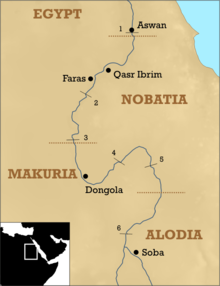Soba is an archaeological site and former town in what is now central Sudan. Three kingdoms existed in medieval Nubia: Nobadia with the capital in Faras, Makuria with the capital in Dongola, and Alodia (Alwa) with the capital in Soba.[1] The latter used to be the capital of the medieval Nubian kingdom of Alodia from the sixth century until around 1500. E. A. Wallis Budge identified it with a group of ruins on the Blue Nile 19 kilometres (12 mi) from Khartoum, where there are remains of a Meroitic temple that had been converted into a Christian church.[2]


In the 10th century Ibn Selim el-Aswani described the city as large and wealthy, but he probably never visited it and modern archaeological investigations show it to have been a moderate centre. Built mainly of red brick, the abandoned city was plundered for building material when Khartoum was founded in 1821. Since the 1990s, development from the growth of suburbs in Greater Khartoum has continued to pose a threat to the ruins.
Archaeological research
editIn its heyday, the city covered approximately 275 hectares, but the excavations carried out prior to 2019 only encompassed about 1% of this area.[3] The research was conducted by, among others, expeditions from the Sudanese National Corporation for Antiquities and Museums (NCAM) and the British Institute in Eastern Africa, mostly as part of salvage excavations resulting from the construction of a tarmac road and the building activity along it. Since the 1900s, modern buildings started to covered the remains, resulting in modern development covering about half of the site.[4]
In 2019, the interdisciplinary project “Soba – the heart of Alwa” was commenced. It is carried out by the Polish Centre of Mediterranean Archaeology University of Warsaw and the Institute of Archaeology and Ethnology of the Polish Academy of Sciences and is directed by Mariusz Drzewiecki (PCMA UW).[1] It aims to study the topography of Soba and determine the extent, spatial structure, and character of each city quarter.[3] A magnetic geophysical prospection revealed unknown parts of medieval Soba.[5] In one of the quarters, large architectural complexes stood at a distance from each other; in another, a clear street grid is visible.[1] Test trenches were also excavated in strategic spots in the city or in places where the results of the geophysical research are not unequivocal.[6] The residence of the kingdom of Alwa’s rulers has not yet been identified.[1]
Notes
edit- ^ a b c d "Soba". pcma.uw.edu.pl. Retrieved 2020-07-28.
- ^ Budge, E. A. Wallis (1970) [1928]. A History of Ethiopia: Nubia and Abyssinia. Oosterhout, the Netherlands: Anthropological Publications. p. 118. OCLC 1070966107.
- ^ a b "Soba – a new research project in Sudan". pcma.uw.edu.pl. Retrieved 2020-07-28.
- ^ Drzewiecki, Mariusz; Ryndziewicz, Robert (2019-07-22). "Developing a New Approach to Research at Soba, the Capital of the Medieval Kingdom of Alwa". Archaeologies. 15 (2): 314–337. doi:10.1007/s11759-019-09370-x. ISSN 1555-8622.
- ^ Ryndziewicz, Robert; Drzewiecki, Mariusz; Banaszek, Łukasz; Herbich, Tomasz; Kiersnowski, Krzysztof (2021-08-16). "Survey of Soba (Sudan)". ArcheoSciences. Revue d'archéométrie (45): 111–114. doi:10.4000/archeosciences.8880. ISSN 1960-1360. S2CID 239622640.
- ^ Mariusz Drzewiecki, Robert Ryndziewicz, Tomasz Michalik, Joanna Ciesielska, Ewa Czyżewska-Zalewska, Maciej Kurcz, Mokhtar Maali Alden Mokhtar Hassan, Soba Expedition. Preliminary report on the season of fieldwork conducted in 2019–2020, report written for the National Corporation for Antiquities and Museums of Sudan.
Further reading
edit- Adams, William Y. (1977). Nubia: Corridor to Africa. Princeton: Princeton University Press. ISBN 0-7139-0579-4.
- Drzewiecki, Mariusz; Michalik, Tomasz (2021). "The beginnings of the Alwan capital of Soba in light of new archaeological evidence". Polish Archaeology in the Mediterranean. 30/2 (30/2). University of Warsaw: 419–438. doi:10.31338/uw.2083-537X.pam30.2.09. ISSN 2083-537X. S2CID 247652880.
- Drzewiecki, Mariusz; Ryndziewicz, R. (2019). Developing a New Approach to Research at Soba, the Capital of the Medieval Kingdom of Alwa. Archaeologies,15.
- Drzewiecki, M., Ryndziewicz, R., Ciesielska J.A., Michalik, T., Kurcz M., Czyżewska-Zalewska E., Adam, R. J. (2020). New fieldwork at Soba East (2019–2020 season), Sudan & Nubia 24, 233–246.
- Drzewiecki, M., Kurcz, M., Ciesielska, J. Michalik T., Czyżewska-Zalewska E., Kiersnowski, K., Ryndziewicz R. (2021). Interdisciplinary Research into the Legacy of the Medieval Metropolis of Soba in a Modern Khartoum Suburb, African Archaeology Revue, 38, 597–623. DOI: 10.1007/s10437-021-09459-1
- Drzewiecki, M., Ryndziewicz, R., Ciesielska, J., Kurcz, M., Michalik, T., & Czyżewska-Zalewska, E. (2022). The spatial organisation of Soba: A medieval capital on the Blue Nile. Antiquity, 96(385) 213-220. DOI: 10.15184/aqy.2021.158
- Shinnie, P. (1961). Excavations at Soba. Sudan Antiquities Service. OCLC 934919402.
- Welsby, Derek (1998). Soba II. Renewed excavations within the metropolis of the Kingdom of Alwa in Central Sudan. British Museum. ISBN 978-0-7141-1903-8.
- Welsby, Derek (2002). The Medieval Kingdoms of Nubia. Pagans, Christians and Muslims Along the Middle Nile. British Museum. ISBN 978-0-7141-1947-2.
- Welsby, Derek; Daniels, C.M. (1991). Soba. Archaeological Research at a Medieval Capital on the Blue Nile. The British Institute in Eastern Africa. ISBN 978-1-872566-02-3.
External links
edit15°31′26″N 32°40′51″E / 15.52389°N 32.68083°E
- Soba – the heart of Alwa – the website of the research project